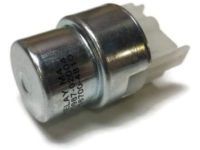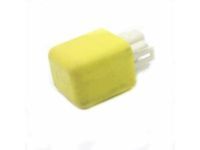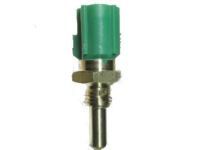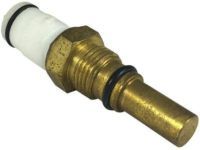| 1996-1997 Toyota 4Runner | LULI, SR5B, SR5V|4 Cyl 2.7L, 6 Cyl 3.4L | 3RZFE, 5VZFE; RZN180L-GKMSKA, RZN180L-GKPSKA, RZN185L-GKMSKA, RZN185L-GKPSKA, VZN180L-GKPGKA, VZN180L-GKPZKA, VZN185L-GKMGKA, VZN185L-GKPGKA, VZN185L-GKPZKA |
| 1992-2001 Toyota Camry | CE, DX, LE, SE, XLE|4 Cyl 2.2L, 6 Cyl 3.0L | 1MZFE, 3VZFE, 5SFE, 5SFNE; MCV10L-AEPDKK, MCV10L-AEPGKA, MCV10L-AEPNKA, MCV10L-AEPNKK, MCV10L-AEPSKA, MCV10L-CCPNKA, MCV10L-CCPNKK, MCV10L-CCPSKA, MCV10L-CEPDKK, MCV10L-CEPGKA, MCV10L-CEPNKA, MCV10L-CEPNKK, MCV10L-CEPSKA, MCV10L-CWPNKA, MCV10L-CWPNKK, MCV20L-AEPDKK, MCV20L-AEPGKA, MCV20L-AEPGKK, MCV20L-AEPNKA, MCV20L-CEMDKA, MCV20L-CEMNKA, MCV20L-CEPDKK, MCV20L-CEPGKA, MCV20L-CEPGKK, MCV20L-CEPNKA, MCV20L-CEPNKK, SXV10L-AEMDKA, SXV10L-AEMDKK, SXV10L-AEMNKK, SXV10L-AEPDKA, SXV10L-AEPDKK, SXV10L-AEPGKA, SXV10L-AEPNKA, SXV10L-AEPNKK, SXV10L-CCMDKA, SXV10L-CCMDKK, SXV10L-CCMNKK, SXV10L-CCPDKA, SXV10L-CCPDKK, SXV10L-CCPNKA, SXV10L-CCPNKK, SXV10L-CEMDKA, SXV10L-CEMDKK, SXV10L-CEMNKK, SXV10L-CEPDKA, SXV10L-CEPDKK, SXV10L-CEPGKA, SXV10L-CEPNKA, SXV10L-CEPNKK, SXV10L-CWMDKK, SXV10L-CWPDKA, SXV10L-CWPDKK, SXV10L-CWPNKA, SXV10L-CWPNKK, SXV20L-AEMDKK, SXV20L-AEPDKK, SXV20L-AEPGKA, SXV20L-AEPNKA, SXV20L-AEPNKK, SXV20L-CEMDKA, SXV20L-CEMDKK, SXV20L-CEMNKK, SXV20L-CEPDKA, SXV20L-CEPDKK, SXV20L-CEPGKA, SXV20L-CEPNKA, SXV20L-CEPNKK, SXV23L-AEPNCA, VCV10L-AEMNKK, VCV10L-AEMSKA, VCV10L-AEPDKA, VCV10L-AEPDKK, VCV10L-AEPGKA, VCV10L-AEPNKA, VCV10L-AEPNKK, VCV10L-AEPSKA, VCV10L-CEMSKA, VCV10L-CEPDKA, VCV10L-CEPGKA, VCV10L-CEPNKA, VCV10L-CEPSKA, VCV10L-CWPNKA, VCV10L-CWPNKK |
| 1990-1999 Toyota Celica | GT, GTS, ST, Turbo 4WD, Turbo All Trac|4 Cyl 1.6L, 4 Cyl 1.8L, 4 Cyl 2.0L, 4 Cyl 2.2L | 3SGTE, 4AFE, 5SFE, 7AFE; AT180L-BCMSKA, AT180L-BCMSKK, AT180L-BCPSKA, AT180L-BCPSKK, AT200L-BCMSKA, AT200L-BCPSKA, AT200L-BLMSKA, AT200L-BLMSKK, AT200L-BLPSKA, AT200L-BLPSKK, ST184L-BCMGKA, ST184L-BCMGKK, ST184L-BCPGKA, ST184L-BCPGKK, ST184L-BKMGKA, ST184L-BKPGKA, ST184L-BLMGKA, ST184L-BLMGKK, ST184L-BLMVKA, ST184L-BLMVKK, ST184L-BLPGKA, ST184L-BLPGKK, ST184L-BLPVKA, ST184L-BLPVKK, ST185L-BLMVZA, ST185L-BLMVZK, ST204L-BCMGKA, ST204L-BCMGKK, ST204L-BCMSKA, ST204L-BCPGKA, ST204L-BCPGKK, ST204L-BCPSKA, ST204L-BKMGKA, ST204L-BKPGKA, ST204L-BLMGKA, ST204L-BLMGKK, ST204L-BLMSKA, ST204L-BLPGKA, ST204L-BLPGKK, ST204L-BLPSKA |
| 1988-2000 Toyota Corolla | CE, DX, GTS, LE, S, SR5, STD, VE|4 Cyl 1.6L, 4 Cyl 1.8L | 1ZZFE, 4AF, 4AFE, 4AGE, 7AFE; AE101L-AEHDKA, AE101L-AEHDKK, AE101L-AEHNKK, AE101L-AEMDKA, AE101L-AEMDKK, AE101L-AEMNKK, AE101L-DEHDKA, AE101L-DEHDKK, AE101L-DEHNKA, AE101L-DEHNKK, AE101L-DEMDKA, AE101L-DEMDKK, AE101L-DEMNKA, AE101L-DEMNKK, AE102L-AEMNKA, AE102L-AEMNKK, AE102L-AEPEKA, AE102L-AEPNKA, AE102L-AEPNKK, AE102L-AWMNKA, AE102L-AWMNKK, AE102L-AWPNKA, AE102L-AWPNKK, AE102L-DEMEKA, AE102L-DEMNKA, AE102L-DEMNKK, AE102L-DEPEKA, AE102L-DEPNKA, AE102L-DEPNKK, AE92L-ACHDKA, AE92L-ACHDUA, AE92L-ACMDKA, AE92L-ACMDUA, AE92L-ACMVFA, AE92L-ACMVFK, AE92L-ACMXKA, AE92L-ACMXKK, AE92L-ACMXUA, AE92L-ACMXUK, AE92L-ACPXKA, AE92L-ACPXKK, AE92L-ACPXUA, AE92L-ACPXUK, AE92L-AEHDKA, AE92L-AEHDKK, AE92L-AEHDUA, AE92L-AEHDUK, AE92L-AEHRKA, AE92L-AEMDKA, AE92L-AEMDKK, AE92L-AEMDUA, AE92L-AEMDUK, AE92L-AEMNKA, AE92L-AEMNKK, AE92L-AEMNUA, AE92L-AEMNUK, AE92L-AEMRKA, AE92L-AEPNKA, AE92L-AEPNKK, AE92L-AEPNUA, AE92L-AEPNUK, AE92L-AWHDKA, AE92L-AWHDKK, AE92L-AWHDUA, AE92L-AWHDUK, AE92L-AWMDKA, AE92L-AWMDKK, AE92L-AWMDUA, AE92L-AWMDUK, AE92L-DEHDKA, AE92L-DEHDKK, AE92L-DEHDUA, AE92L-DEHDUK, AE92L-DEHRKA, AE92L-DEMDKA, AE92L-DEMDKK, AE92L-DEMDUA, AE92L-DEMDUK, AE92L-DEMNKA, AE92L-DEMNKK, AE92L-DEMNUA, AE92L-DEMNUK, AE92L-DEMRKA, AE92L-DEPNKA, AE92L-DEPNKK, AE92L-DEPNUA, AE92L-DEPNUK, AE95L-AEMDKA, AE95L-AEMDKK, AE95L-AEPDKA, AE95L-AEPDKK, AE95L-CWMDKA, AE95L-CWMDKK, AE95L-CWMXKA, AE95L-CWMXKK, AE95L-CWPDKA, AE95L-CWPDKK, ZZE110L-DEHRKA, ZZE110L-DEHRKK, ZZE110L-DEMDKA, ZZE110L-DEMDKK, ZZE110L-DEMNKA, ZZE110L-DEMRKA, ZZE110L-DEMRKK, ZZE110L-DEMSKA, ZZE110L-DEMSKK, ZZE110L-DEPDKA, ZZE110L-DEPDKK, ZZE110L-DEPEKA, ZZE110L-DEPGKA, ZZE110L-DEPNKA, ZZE110L-DEPNKK, ZZE110L-DEPQKA, ZZE110L-DEPRKA, ZZE110L-DEPRKK, ZZE110L-DEPSKA, ZZE110L-DEPSKK, ZZE110L-DEPXKA |
| 1990-1995 Toyota MR2 | 4 Cyl 2.0L, 4 Cyl 2.2L | 3SGTE, 5SFE; SW20L-ACMZZA, SW20L-AJMZZA, SW20L-AJMZZK, SW21L-ACMZKA, SW21L-ACPZKA, SW21L-AJMZKA, SW21L-AJMZKK, SW21L-AJPZKA |
| 1992-1999 Toyota Paseo | 4 Cyl 1.5L | 5EFE; EL44L-DCMSKA, EL44L-DCMSKK, EL44L-DCPSKA, EL44L-DCPSKK, EL54L-DCMSKA, EL54L-DCMSKK, EL54L-DCPSKA, EL54L-DCPSKK, EL54L-DKMSKA, EL54L-DKPSKA |
| 1996-2000 Toyota RAV4 | 4 Cyl 2.0L | 3SFE; SXA10L-AKMGKA, SXA10L-AKPGKA, SXA10L-AZMGKA, SXA11L-AWMGKA, SXA11L-AWPGKA, SXA15L-AKMGKA, SXA15L-AKPGKA, SXA15L-AZMGKA, SXA15L-AZPGKA, SXA16L-AWMGKA, SXA16L-AWPGKA |
| 1999-2002 Toyota Solara | 4 Cyl 2.2L, 4 Cyl 2.4L, 6 Cyl 3.0L | 1MZFE, 2AZFE, 5SFE; ACV20L-GCMNKA, ACV20L-GCPNKA, ACV20L-GCPNKK, ACV20L-GKPNKA, MCV20L-GCMNKA, MCV20L-GCMNKK, MCV20L-GCPNKA, MCV20L-GCPNKK, MCV20L-GKPNKA, MCV20L-GKPNKK, SXV20L-GCMNKA, SXV20L-GCPNKA, SXV20L-GCPNKK, SXV20L-GKPNKA |
| 1993-1998 Toyota T100 | DLX, SR5, STD|4 Cyl 2.7L, 6 Cyl 3.0L, 6 Cyl 3.4L | 3RZFE, 3VZE, 5VZFE; RCK10L-TRMRKA, RCK10L-TRSRKA, VCK10L-THMREA, VCK10L-THSREA, VCK10L-TRMREA, VCK10L-TRMREK, VCK10L-TRMSEA, VCK10L-TRMSEK, VCK10L-TRSREA, VCK10L-TRSREK, VCK10L-TRSSEA, VCK10L-TRSSEK, VCK11L-CRMDKA, VCK11L-CRMDKK, VCK11L-CRMSKA, VCK11L-CRSDKA, VCK11L-CRSDKK, VCK11L-CRSSKA, VCK11L-THMDKA, VCK11L-THSDKA, VCK11L-TRMDKA, VCK11L-TRMDKK, VCK11L-TRMRKA, VCK11L-TRMSKA, VCK11L-TRSDKA, VCK11L-TRSDKK, VCK11L-TRSSKA, VCK20L-TRMREA, VCK20L-TRMREK, VCK20L-TRMSEA, VCK20L-TRMSEK, VCK20L-TRSREA, VCK20L-TRSREK, VCK20L-TRSSEA, VCK20L-TRSSEK, VCK21L-CRMDKA, VCK21L-CRMDKK, VCK21L-CRMSKA, VCK21L-CRMSKK, VCK21L-CRSDKA, VCK21L-CRSDKK, VCK21L-CRSSKA, VCK21L-CRSSKK, VCK21L-TRMDKA, VCK21L-TRMDKK, VCK21L-TRMSKA, VCK21L-TRMSKK, VCK21L-TRSDKA, VCK21L-TRSDKK, VCK21L-TRSSKA, VCK21L-TRSSKK |
| 1995-1998 Toyota Tacoma | DLX, SR5|4 Cyl 2.4L, 4 Cyl 2.7L, 6 Cyl 3.4L | 2RZFE, 3RZFE, 5VZFE; RZN140L-TRMDKAB, RZN140L-TRSDKAB, RZN150L-CRMDKAB, RZN150L-CRSDKAB, RZN161L-TRMDKAB, RZN161L-TRPDKAB, RZN171L-CRMDKAB, RZN171L-CRPDKAB, RZN191L-TRPDKAB, RZN196L-CRPDKAB, VZN150L-CRMDKAB, VZN150L-CRSDKAB, VZN160L-TRMDKAB, VZN170L-CRMDKAB, VZN170L-CRMGKAB, VZN170L-CRPDKAB, VZN170L-CRPGKAB, VZN195L-CRPDKAB |










